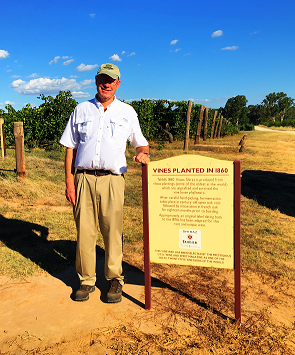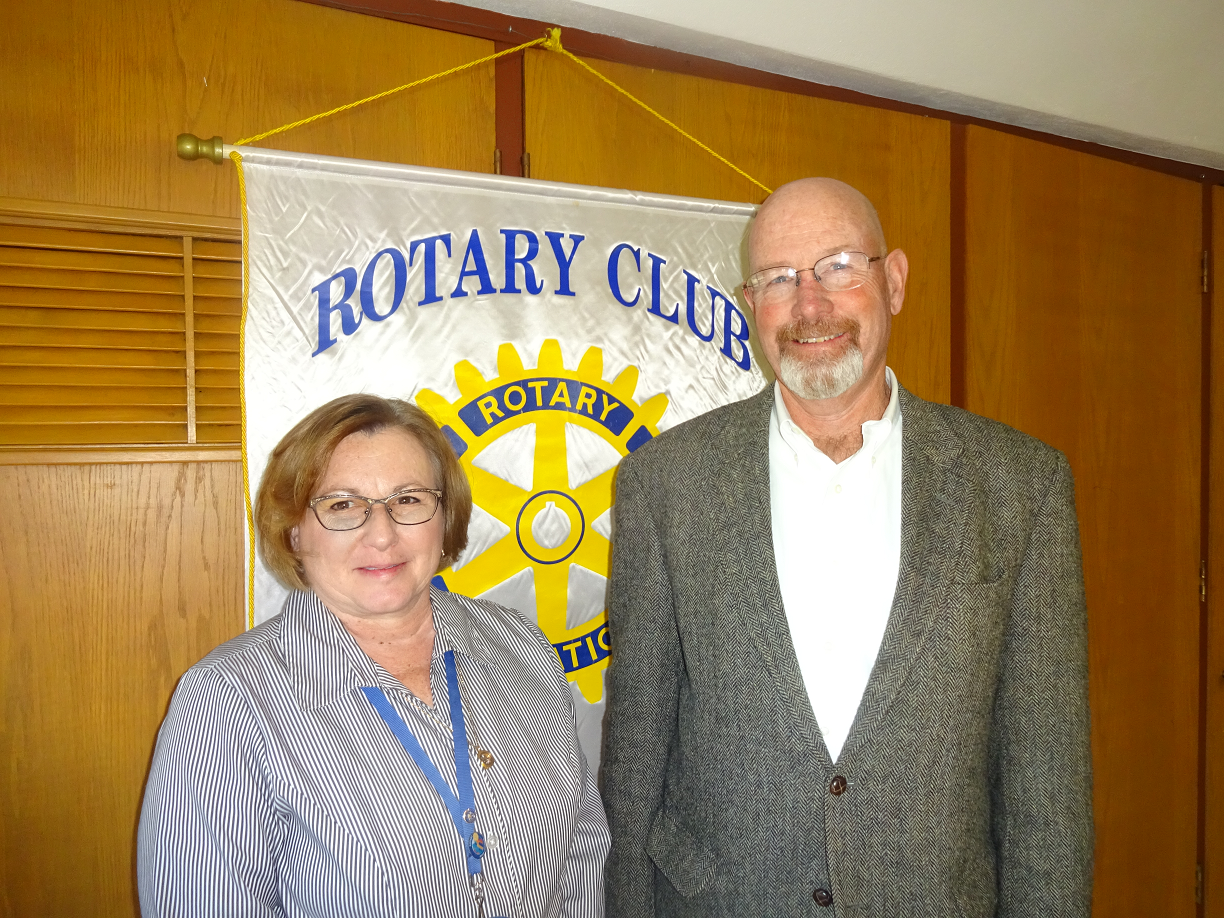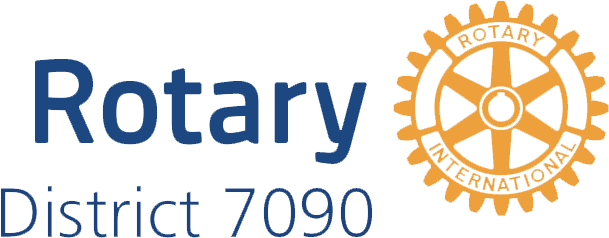BEHOLD AUSTRALIA 
What do flying foxes, an arid climate and clay soils that are about 250 million years old have in common? These are some of the challenges facing fruit farmers in the Melbourne area of Australia as outlined by Frederick (“Fred”) Johnson, Jr. during his November 28 presentation for the Rotary Club of Westfield-Mayville’s Rural-Urban Day special program. Area high school students, some school staff and agricultural community members were invited as guests. Including Rotarians, 49 people were in attendance. This event was held in the fellowship hall of the United Methodist Church in Westfield, NY.
Pictured, Fred Johnson, Jr. visited a 150-plus year old Shiraz vineyard at the Tahbilk Winery in the Goulburn Valley wine region of Australia during his VTT experience in late Feb. and early Mar. 2017.
 Johnson, owner and vineyard manager of Johnson Estate Winery in Westfield, New York, visited Australia from February 25 to March 19, 2017 as a member of the Rotary District 7090 Vocational Training Team (VTT). Other VTT members included Rotarian Tom O’Neill, team leader, and team members - Torrie Warner and Brian Kerry. Their VTT trip was sponsored by The Rotary Foundation and Rotary District 7090 and hosted by the Rotary District 9790 in Australia.
Johnson, owner and vineyard manager of Johnson Estate Winery in Westfield, New York, visited Australia from February 25 to March 19, 2017 as a member of the Rotary District 7090 Vocational Training Team (VTT). Other VTT members included Rotarian Tom O’Neill, team leader, and team members - Torrie Warner and Brian Kerry. Their VTT trip was sponsored by The Rotary Foundation and Rotary District 7090 and hosted by the Rotary District 9790 in Australia.This special Rural-Urban Day program of the Rotary Club of Westfield-Mayville was co-sponsored by Janese Berkhouse, Club President, and Mary Swanson, Club President-Elect. Swanson, who presided at the November 28 session, introduced Johnson. Also, Dan Smith, Rotary District 7090 VTT Chair, briefly explained the purpose of the VTT project.
This year’s VTT focus was fruit farming. Smith stated, “This VTT was very successful in its interaction of our Canadian and US members with their Australian hosts in the many venues and contacts in the Goulburn Valley, their fruit growing region. Both our Rotary District 7090 and the Australian Rotary District 9790 benefited greatly by sharing experiences with production methods, pest control, economics, labor and marketing issues. Our Rotary District 7090 will host the Australian VTT for several weeks in late May to early June 2018 in order to continue the relationships and sharing of fruit farming experiences.”
About his VTT experience, Johnson stated, “This past February and March, I was fortunate enough to be selected to a four-person Vocational Training Team (VTT) sponsored by The Rotary Foundation. We visited the largest fruit growing region in Australia (and significant wine region as well). The team was selected from our local Rotary District 7090, which includes the fruit belt of Southern Ontario. My three teammates were experienced fruit growers and marketers from Canada. We were hosted by local Australian families and spent three weeks visiting all sorts of agricultural establishments in the Murray River basin of northern Victoria State. From research institutions to high tech, valley-wide irrigation systems, fruit markets, packing houses and large, well kept orchards, we were warmly welcomed to a vigorous and interesting tour and information exchange.” He continued, “During this coming May and June, we will be welcoming a similar VTT group from that very same Rotary District in Australia to our Rotary District 7090 here in Western New York and Southern Ontario. I look forward to helping make the team members’ stay every bit as productive and pleasant as ours was Down Under.”
Johnson and his VTT partners traveled through 12 different time zones and went 2 seasons away to reach Wangratta, which is two-plus hours outside of Melbourne in Victoria State, Australia. This area is on about the same latitude as Washington, D.C. When it is November here, the climate there is like our May. Winter temperatures there range from highs in the 60s to lows in the 30s.
During his program, Johnson noted, “Australia is by far the oldest continent on our planet. Its soils are about 250 million years old, while ours are about 15,000 years old. The soil of the many fruit farms we visited consisted of very hard tan clay. Because the region is very arid, irrigation systems made of drip tubes are everywhere.”
He said, “The Murray River basin is Australia’s fruit basket. This river is like our Mississippi River. The Murray River provides most of the water for growing crops. Fruits grown there include peaches,
kiwis, cherries, pomegranates, apples, pears, grapes and even lemons and limes on the higher elevations. Hail nets are put over the pear orchards to keep flying foxes (bats) out of the orchards.”
He also noted that if there is sufficient water, the farmers are able to grow two rounds of crops per year. Their fruits are exported to China and northern markets. In addition to many fruit farms in the area, there were some big livestock farms.
“Because the climate is so arid,” Johnson said, “crop diseases, such as fire blight on pears, are not prevalent. As in our area, the invasive species of the Phylloxera bug does affect some of the grape crops, particularly old-world wine grapes, but it is not as widespread there.” He added that in general Australia has various quarantine facilities around the country. He and his VTT partners visited one outside of Melbourne, that not only checked plants, but also kept livestock.
Johnson said that similar to our region, farmers there have the big challenge of getting sufficient workers to help on the farms, which is made more difficult because Australia is an island. Workers are flown in from Indonesia, Taiwan, Malaysia and other places. The workers must obtain a six-month visa to be employed on the farms, and must check out at the end of their stay. The minimum hourly wage there is Australian $17, which is about US$15.
Another interesting point that Johnson made was that in Australia landholders have a deed of occupancy. The “Crown” owns the mineral and water rights, and it has the right of passage. The farmers there are against “fracking,” not for environmental reasons, but because they do not own the mineral rights to the land. Basically, they would get nothing out of it except bulldozer tracks on their land.
Where Johnson and the other VTT members visited was the Goulburn Valley wine region, which stretches from Seymour to Echuca on the Murray River. Wine production began in this region during the 1860’s during the Gold Rush. VTT participants visited numerous tasting rooms and wineries, including the Tahbilk Winery, which was founded in 1861. Tourists to this area may take steam boat rides to the various wineries. These former work vessels are wood-fired steam boats.
Johnson expressed gratitude to his VTT’s “very hospitable and welcoming hosts” of Rotary District 9790 in Australia, and he is looking forward to returning their hospitality when the inbound Vocational Training Team visits our area this next spring. The Rotary Club of Westfield-Mayville proudly congratulates Fred Johnson and the other VTT members on their commitment of making the sojourn to Australia to learn more about fruit farming, and then return and share their valuable experience.
